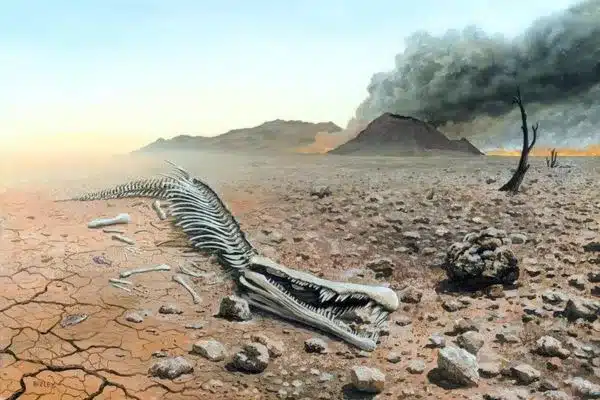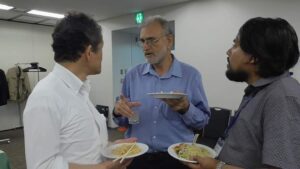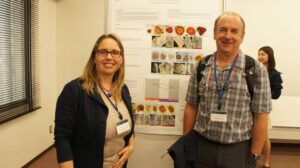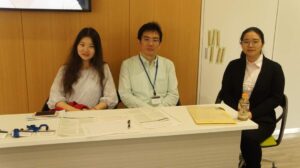K-Pg Mass extinction
One of the ‘Five Big’ mass extinctions occurred at 66 million years ago at the Cretaceous/Paleogene boundary, marked by the extinction of dinosaurs and shallow marine organisms (Smit et al. 1980; Schulte et al. 2010.

Only 12% of the land-dwelling forms but 90% of species in the freshwater assemblage survived, while marine plankton diversity and marine productivity decreased significantly except for the benthic foraminiferal species.
An asteroid hit of about 12 Km diameter in size at Chixulab, Mexico is the widely known cause of the KPg mass extinction.
K-Pg mass extinction
However recent finding shows that Plume volcanism might be one of the causes of KPg mass extinction. Hence, to find the robust cause of the mechanism is the recent need for the community and the researchers of the modern world.

The Cretaceous-Paleogene Extinction Event: A Catastrophic End
The Cretaceous period, spanning approximately 79 million years, was a time of remarkable biodiversity. Dinosaurs dominated the land, while marine reptiles and flying pterosaurs filled the skies.
However, this era of dominance abruptly ended with a catastrophic event at the Cretaceous-Paleogene (K-Pg) boundary, marking the demise of non-avian dinosaurs and numerous other species.
A leading hypothesis for this mass extinction is the asteroid impact theory, proposed by scientists led by Luis Alvarez, a Nobel Prize-winning physicist. The Alvarez team discovered an unusually high concentration of iridium, a rare element on Earth but abundant in asteroids, at the K-Pg boundary.
This evidence, along with other geological and fossil data, strongly suggests that a massive asteroid collided with Earth, triggering a global catastrophe.
The impact of this asteroid, believed to have struck the Gulf of Mexico, unleashed a cataclysmic chain of events. The collision generated immense energy, causing widespread fires, earthquakes, and tsunamis.
More importantly, it ejected vast amounts of debris into the atmosphere, blocking sunlight reaching the Earth’s surface. This led to a global “impact winter,” characterized by plummeting temperatures and the collapse of the food chain.
The absence of sunlight disrupted photosynthesis, leading to the decline of plant life, which in turn affected herbivores. As herbivore populations dwindled, carnivores faced food shortages, ultimately leading to the extinction of countless species.
The delicate balance of the Cretaceous ecosystem was shattered, and the world entered a new era, marked by the rise of mammals and the eventual emergence of humans.
Understanding the Cretaceous-Paleogene extinction event is crucial for comprehending the Earth’s history and the potential consequences of catastrophic events. By studying the past, scientists can better prepare for future challenges and develop strategies to mitigate the impact of similar disasters.
The Devastation of the Chicxulub Impact
The Cretaceous-Paleogene (K-Pg) extinction event, approximately 66 million years ago, marked a dramatic turning point in Earth’s history. At the heart of this cataclysmic event was the impact of a massive asteroid in the Gulf of Mexico, near the present-day Chicxulub region.
The consequences of this collision were catastrophic. The impact generated immense energy, triggering earthquakes, tsunamis, and widespread wildfires. However, the most devastating effect was the injection of vast quantities of dust and debris into the atmosphere, blocking sunlight and causing global temperatures to plummet. This “impact winter” disrupted the delicate balance of the planet’s ecosystem, leading to the demise of non-avian dinosaurs and countless other species.
The evidence supporting the asteroid impact theory is compelling. A thin layer of iridium, a rare element on Earth but abundant in asteroids, has been found at the K-Pg boundary worldwide. This, coupled with shocked quartz and other impact-related materials, provides strong support for the hypothesis.
The Chicxulub impact serves as a stark reminder of the fragility of Earth’s ecosystems and the potential consequences of catastrophic events. Understanding this event is crucial for developing strategies to mitigate the risks posed by future asteroid threats and for appreciating the resilience of life on our planet.







